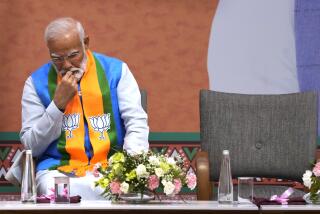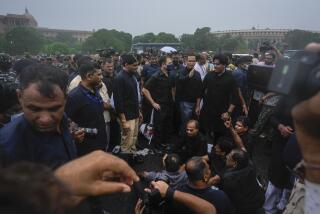ASIA : India’s Economic Reform Runs Into Political Reality
- Share via
NEW DELHI — As India’s summer was beginning in sweltering earnest Tuesday around noontime, the sorely overtaxed power grid in the capital gave way, and even the Parliament building was plunged temporarily into darkness.
The sound system and lights failed as a deputy from Tamil Nadu was speaking, and fans stopped churning the tepid air.
“For once, the common man and the prime minister shared the same fate and had to sweat it out together,” one newspaper commented waspishly.
Perspiring may be something Prime Minister P.V. Narasimha Rao has been doing a good deal of lately. In the nearly four years since he took the helm of the world’s largest democracy, the political empire of the Congress (I) Party has been shrinking at an alarming rate.
As a result of disastrous, back-to-back performances in local elections, Congress now controls the governments in states where only 210 million of India’s 900 million people live.
Under Rao, the country’s two most important cities, Bombay and New Delhi, have passed into opposition hands.
Alarmed over the looming possibility of a wipeout in national elections, which must be held by spring, 1996, Rao and his ministers are pumping the brakes on the process of economic reform they launched in June, 1991.
Last month, Finance Minister Manmohan Singh announced an unabashedly voter-pleasing budget that includes so much income-tax relief, poverty alleviation plans and other concessions that the government forecasts an $18.6-billion deficit.
The policies of supply and demand, Singh admitted, weren’t having the hoped-for trickle-down effects. “The fruits of growth,” he said, “will also take some time to reach the poorest and weakest members of society.”
Subsidies for food, fertilizer and export promotion are being hiked by $810 million, to a total of $3.5 billion for the current fiscal year. Outlays on health, education and other social welfare programs are being boosted.
On Monday, Michel Camdessus, managing director of the International Monetary Fund, warned of signs of a “slowdown” in India’s move toward free-market economics. A recently released IMF survey complains of India’s continued high trade barriers and slow reform of its public sector.
Rao has contended that the new budget is a “continuation of the reforms launched four years ago with more emphasis on anti-poverty measures.” However, the Associated Chambers of Commerce and Industry of India unhesitatingly branded it “populist” and a “departure from the earlier investment-friendly budgets.”
But in the uneasy ranks of the Congress party, some are panicking at the possibility that Singh’s budget doesn’t do enough to convince alienated voters, especially the poor, that the government is more worried about them than India’s international bond rating.
One rebel Congress leader, P.R. Kumaramangalam, has threatened to introduce nine amendments to the budget, including a 50% subsidy on food grains for the destitute.
*
Even opposition parties pledged their backing for such changes.
A test vote Friday indicated that Rao loyalists and sympathizers in other parties appeared to have the votes to beat back the mutiny in Congress and vote the budget into law. But what next?
In one humiliating setback to its efforts to bring India more into the international economic mainstream, Rao’s government has been unable to muster a majority in Parliament’s upper house for key changes in the patent law. More setbacks may lie ahead.
Some observers believe that Rao is marching the party that led the fight for India’s independence straight to its political Waterloo. “The descent has been amazing, especially for a party which was assigned with a historic role,” said Rajni Kothari, a former Planning Commission member.
Kiran Saxena, chairwoman of the Center for Political Studies at Jawaharlal Nehru University, agrees that the support of Congress is eroding. But Rao’s party still has a lock on the political center at the national level, she said.
In view of India’s history, the number Rao needs to worry about is the inflation rate, now 9.4%. Indian voters have not been shy to vote out leaders who proved unable to keep prices down.
“For a government trying desperately in an election year to be pro-poor, nothing could be worse than the steady rise in prices by over 50% in the past four years,” Sunil Jain, economics correspondent for the respected India Today magazine, pointed out.
More to Read
Sign up for Essential California
The most important California stories and recommendations in your inbox every morning.
You may occasionally receive promotional content from the Los Angeles Times.









